|
Read 12904593 times
Connect me to:
|
Salt and Sauce in the Chinese CulinarySauces, Seasonings, and Spices
Spring Volume: 2009 Issue: 16(1) page(s): 9 and 10
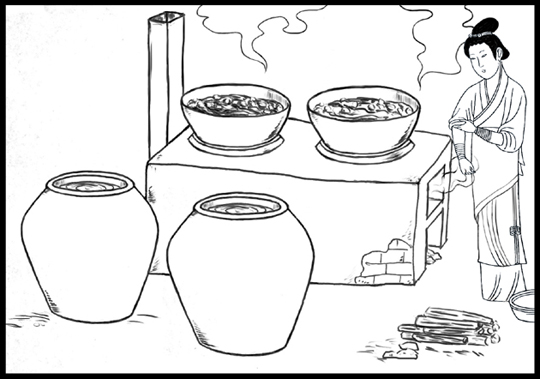 There is a well-known ancient Chinese saying advising of seven necessary daily items. Two of them are salt and sauce, the others firewood, rice, oil, vinegar and tea. These seven necessities were first recorded by Wu Zimu during the Song Dynasty (960 - 1279 CE). What was not said then is the interaction between them. Do you know these two items developed independently in China? Do you know that each strongly impacts and effects the other? Questions arise as to how salt and sauce work together and how they work independently. Do you know some ways? Many materials are called salts, many can be called sauces, lots known about salt, but little known about Chinese sauces. There is a well-known ancient Chinese saying advising of seven necessary daily items. Two of them are salt and sauce, the others firewood, rice, oil, vinegar and tea. These seven necessities were first recorded by Wu Zimu during the Song Dynasty (960 - 1279 CE). What was not said then is the interaction between them. Do you know these two items developed independently in China? Do you know that each strongly impacts and effects the other? Questions arise as to how salt and sauce work together and how they work independently. Do you know some ways? Many materials are called salts, many can be called sauces, lots known about salt, but little known about Chinese sauces.
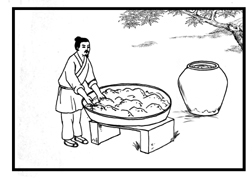 The Chinese usually divide sauces into different types. The first and earliest are meat sauces. This sauce group include those from four-legged animals and those made from poultry including chicken and goose. There are also meat sauces made from wild beasts and from small animals such as rabbits. Another group of sauces include those from plant sources. A third group are made with different fish. Meat sauces are the most ancient. The Chinese usually divide sauces into different types. The first and earliest are meat sauces. This sauce group include those from four-legged animals and those made from poultry including chicken and goose. There are also meat sauces made from wild beasts and from small animals such as rabbits. Another group of sauces include those from plant sources. A third group are made with different fish. Meat sauces are the most ancient.
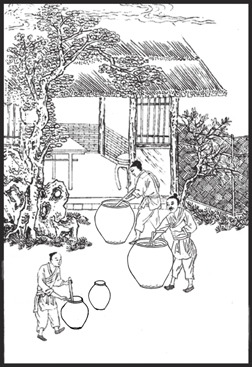 As early as during the Zhou dynasty (1045 - 256 BCE), there is a record of an old meat sauce recipe. It appears in the Li Ji, a classical Chinese book compiled during the time of the Western Han dynasty (206 - 25 BCE). It tells about earlier times when it was used. In the Li Ji there are two kinds of meat sauces. One is made without bones and called Hai. The other is made with bones and called Ni. As early as during the Zhou dynasty (1045 - 256 BCE), there is a record of an old meat sauce recipe. It appears in the Li Ji, a classical Chinese book compiled during the time of the Western Han dynasty (206 - 25 BCE). It tells about earlier times when it was used. In the Li Ji there are two kinds of meat sauces. One is made without bones and called Hai. The other is made with bones and called Ni.
The primary sauce material used in Chinese daily life today is made from a plant, the soybean. Commonly called soy sauce, it was and is fermented using soybeans and technology common to making leaven. There are enzymatic effects and in the process of making these sauce types, salt is added. Actually, fermentation in all sauce processing needs salt. Different salts provide different qualities in the sauce making process. 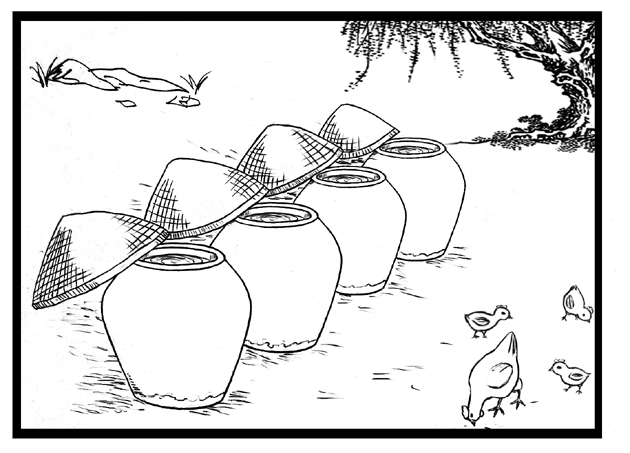 In ancient China, most people were poor and had a hard life. They cherished and treasured food, and they learned how to preserve it. Their efforts led to advanced preservation techniques, and in the process, they learned to make many fermented sauces using different materials. These yielded sauce items such as tan hai which is a gravy-like savory sauce slightly acidic. They also learned to make chi hai, a sauce using ant eggs. In addition, they learned to make a sauce called tu hai using rabbit meat, a tai using bamboo shoots, and so on. There are records of these sauces in the Zhou Li, (Ruan Yuan, Shi San Jing Zhu Shu, Beijing: Zhonghua Shuju, 1980, p.675). In ancient China, most people were poor and had a hard life. They cherished and treasured food, and they learned how to preserve it. Their efforts led to advanced preservation techniques, and in the process, they learned to make many fermented sauces using different materials. These yielded sauce items such as tan hai which is a gravy-like savory sauce slightly acidic. They also learned to make chi hai, a sauce using ant eggs. In addition, they learned to make a sauce called tu hai using rabbit meat, a tai using bamboo shoots, and so on. There are records of these sauces in the Zhou Li, (Ruan Yuan, Shi San Jing Zhu Shu, Beijing: Zhonghua Shuju, 1980, p.675).
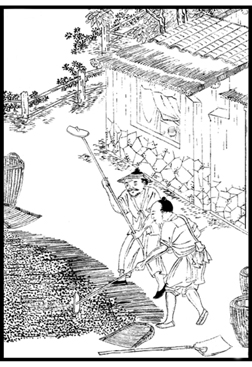 Ancient Chinese people not only used sauces in their culinary, they used them for their health. One of the latter uses was to reduce dermatitis, an inflammation of the skin. They did this because they learned that salt kills what we now call bacteria. Their many recipes for sauce and salt for eating and for curing are also found in the epic Ming Dynasty (1368 - 1644 CE) volume, the Ben Cao Gang Mu. That was written by Li Shizhen (1518 - 1593 CE).
Chinese sauces have a long history of evolution and development. The sauce made from soybeans, namely soy sauce, is not as old as are meat sauces, but today it is the king of all fermented seasonings. Many sauces change the flavor and appearance of foods, as do soy sauces. Different ones make for a large variety of different food tastes including all sauces from soybeans. Ancient Chinese people not only used sauces in their culinary, they used them for their health. One of the latter uses was to reduce dermatitis, an inflammation of the skin. They did this because they learned that salt kills what we now call bacteria. Their many recipes for sauce and salt for eating and for curing are also found in the epic Ming Dynasty (1368 - 1644 CE) volume, the Ben Cao Gang Mu. That was written by Li Shizhen (1518 - 1593 CE).
Chinese sauces have a long history of evolution and development. The sauce made from soybeans, namely soy sauce, is not as old as are meat sauces, but today it is the king of all fermented seasonings. Many sauces change the flavor and appearance of foods, as do soy sauces. Different ones make for a large variety of different food tastes including all sauces from soybeans.
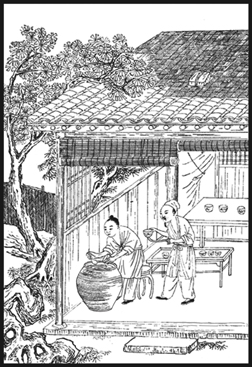 After the Zhou Dynasty (1066 - 256 BCE), Chinese sauce became an independent food, not only a seasoning. As such, it and other sauces can be and are eaten alone. Some are added to flavor a large variety of cooked foods, and some cooked with foods to change their taste. After the Zhou Dynasty (1066 - 256 BCE), Chinese sauce became an independent food, not only a seasoning. As such, it and other sauces can be and are eaten alone. Some are added to flavor a large variety of cooked foods, and some cooked with foods to change their taste.
Fish sauces also played and still play important roles in people's lives in China. This is especially true for those who lived in the Yangzi and Yellow River regions. While Chinese fish sauces are also ancient, they are newer than meat sauces, and they have heir own unique features. They are generally referred to as yu hai. Some fish sauces are recorded in the Zhou Li, but these were not as popular. Do you know that these sauces compare with and relate to liquamen used in ancient Rome? However, Chinese fish sauces are made differently, they use different materials and different processing techniques. Nonetheless, they are as ancient as Roman liquamen sauces, maybe older. There are many tales about both of these sauces in the east and the west. In addition to uses in foods, Chinese sauces and salts are used alone and together in medical treatments. A Chinese herbal sauce is said to cure a fever and fretfulness and it can detoxify vegetables. This is recorded by Hu Sihui in the Yin Shan Zheng Yao, (Beijing: China Commercial Press, 1988, p.240). Hu Sihui was a famous doctor who lived during the Yuan Dynasty (1271 - 1368 CE). He and others have indicated that plant sauces containing Chinese herbals when mixed with salt can help defecation, while others kill winged insects that come into the ear. This latter use was recorded by Li Shizhen in the Ben Cao Gang Mu (Ibid). Many recipes, these and others, can be found in numerous ancient and more recent Chinese medical tomes. The medicinal value and availability of herbal sauces make them important to those in Chinese medical fields. In ancient China, most people had no money to buy medicine or to see a doctor. That may be why the medical effect of salt and sauce were widely accepted and adopted by the Chinese people.
We now know that salt is essential for life, and that it is a most popular food seasoning. We also know that white crystal salt granules enrich the relish of sauce. An inherent link between salt and sauce is that during the production of a sauce, a certain amount of salt is added to control its taste and impact any fermentation processes. The exact amount affects quality and taste when making every sauce. Different amounts and different salts impact different fermented sauces differently. Not all salts are alike. There are differences be the salts come from the sea, from lakes, from springs, and in salts extracted from salt marshes. Each provides a different texture and taste. Professor Newman, this magazine's editor, said at a recent sauce symposium that was written about in Flavor and Fortune's Volume 15(3) on page 28, that taste is the real reason for the continuous development of Chinese sauces. She indicated that in the production of Chinese sauces, salt quality influences sauce taste. But, does she know the ancient Chinese saying: 'Oh salt, he is a General in the Chinese cuisine" (Ban Gu, Han Shu, Beijing: Zhonghua Shuju, 1962, p. 1183)? This saying, used earlier but recorded by Ban Gu during the Eastern Han Dynasty (25 - 220 CE), shows the importance of salt in all sauces. Salt crystals bring cultural meanings and give people food choices in sauce manufacture. Salt supplements enhance each sauce, and Chinese food preparation reflects people's affection for sauce and salt in their lives. In China, people do not get their salt from a salt shaker. They get theirs using many different sauces as they prepare their dishes. Thus, in China, salt and sauce are great partners. People need both and they ingest both at every meal.
_____
Zhou Hongcheng is a graduate student in the College of Tourism at Zhejiang Gongshang University in Hangzhou, in the Zhejiang Province of China. If you have questions, he can be contacted at zhc180@hotmail. com The pictures accompanying this article show ancient soy sauce making. They are sent with compliments of the Shaoxing Soy Sauce museum's curator, Professor Zhao.
|

 There is a well-known ancient Chinese saying advising of seven necessary daily items. Two of them are salt and sauce, the others firewood, rice, oil, vinegar and tea. These seven necessities were first recorded by Wu Zimu during the Song Dynasty (960 - 1279 CE). What was not said then is the interaction between them. Do you know these two items developed independently in China? Do you know that each strongly impacts and effects the other? Questions arise as to how salt and sauce work together and how they work independently. Do you know some ways? Many materials are called salts, many can be called sauces, lots known about salt, but little known about Chinese sauces.
There is a well-known ancient Chinese saying advising of seven necessary daily items. Two of them are salt and sauce, the others firewood, rice, oil, vinegar and tea. These seven necessities were first recorded by Wu Zimu during the Song Dynasty (960 - 1279 CE). What was not said then is the interaction between them. Do you know these two items developed independently in China? Do you know that each strongly impacts and effects the other? Questions arise as to how salt and sauce work together and how they work independently. Do you know some ways? Many materials are called salts, many can be called sauces, lots known about salt, but little known about Chinese sauces. The Chinese usually divide sauces into different types. The first and earliest are meat sauces. This sauce group include those from four-legged animals and those made from poultry including chicken and goose. There are also meat sauces made from wild beasts and from small animals such as rabbits. Another group of sauces include those from plant sources. A third group are made with different fish. Meat sauces are the most ancient.
The Chinese usually divide sauces into different types. The first and earliest are meat sauces. This sauce group include those from four-legged animals and those made from poultry including chicken and goose. There are also meat sauces made from wild beasts and from small animals such as rabbits. Another group of sauces include those from plant sources. A third group are made with different fish. Meat sauces are the most ancient.  As early as during the Zhou dynasty (1045 - 256 BCE), there is a record of an old meat sauce recipe. It appears in the Li Ji, a classical Chinese book compiled during the time of the Western Han dynasty (206 - 25 BCE). It tells about earlier times when it was used. In the Li Ji there are two kinds of meat sauces. One is made without bones and called Hai. The other is made with bones and called Ni.
As early as during the Zhou dynasty (1045 - 256 BCE), there is a record of an old meat sauce recipe. It appears in the Li Ji, a classical Chinese book compiled during the time of the Western Han dynasty (206 - 25 BCE). It tells about earlier times when it was used. In the Li Ji there are two kinds of meat sauces. One is made without bones and called Hai. The other is made with bones and called Ni.  In ancient China, most people were poor and had a hard life. They cherished and treasured food, and they learned how to preserve it. Their efforts led to advanced preservation techniques, and in the process, they learned to make many fermented sauces using different materials. These yielded sauce items such as tan hai which is a gravy-like savory sauce slightly acidic. They also learned to make chi hai, a sauce using ant eggs. In addition, they learned to make a sauce called tu hai using rabbit meat, a tai using bamboo shoots, and so on. There are records of these sauces in the Zhou Li, (Ruan Yuan, Shi San Jing Zhu Shu, Beijing: Zhonghua Shuju, 1980, p.675).
In ancient China, most people were poor and had a hard life. They cherished and treasured food, and they learned how to preserve it. Their efforts led to advanced preservation techniques, and in the process, they learned to make many fermented sauces using different materials. These yielded sauce items such as tan hai which is a gravy-like savory sauce slightly acidic. They also learned to make chi hai, a sauce using ant eggs. In addition, they learned to make a sauce called tu hai using rabbit meat, a tai using bamboo shoots, and so on. There are records of these sauces in the Zhou Li, (Ruan Yuan, Shi San Jing Zhu Shu, Beijing: Zhonghua Shuju, 1980, p.675). Ancient Chinese people not only used sauces in their culinary, they used them for their health. One of the latter uses was to reduce dermatitis, an inflammation of the skin. They did this because they learned that salt kills what we now call bacteria. Their many recipes for sauce and salt for eating and for curing are also found in the epic Ming Dynasty (1368 - 1644 CE) volume, the Ben Cao Gang Mu. That was written by Li Shizhen (1518 - 1593 CE).
Chinese sauces have a long history of evolution and development. The sauce made from soybeans, namely soy sauce, is not as old as are meat sauces, but today it is the king of all fermented seasonings. Many sauces change the flavor and appearance of foods, as do soy sauces. Different ones make for a large variety of different food tastes including all sauces from soybeans.
Ancient Chinese people not only used sauces in their culinary, they used them for their health. One of the latter uses was to reduce dermatitis, an inflammation of the skin. They did this because they learned that salt kills what we now call bacteria. Their many recipes for sauce and salt for eating and for curing are also found in the epic Ming Dynasty (1368 - 1644 CE) volume, the Ben Cao Gang Mu. That was written by Li Shizhen (1518 - 1593 CE).
Chinese sauces have a long history of evolution and development. The sauce made from soybeans, namely soy sauce, is not as old as are meat sauces, but today it is the king of all fermented seasonings. Many sauces change the flavor and appearance of foods, as do soy sauces. Different ones make for a large variety of different food tastes including all sauces from soybeans.  After the Zhou Dynasty (1066 - 256 BCE), Chinese sauce became an independent food, not only a seasoning. As such, it and other sauces can be and are eaten alone. Some are added to flavor a large variety of cooked foods, and some cooked with foods to change their taste.
After the Zhou Dynasty (1066 - 256 BCE), Chinese sauce became an independent food, not only a seasoning. As such, it and other sauces can be and are eaten alone. Some are added to flavor a large variety of cooked foods, and some cooked with foods to change their taste.